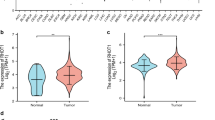Abstract
Programmed cell death 6 (PDCD6) plays an important role in apoptotic cell death and tumorigenesis. In this study, we investigated whether PDCD6 contributes to the development and/or progression of gastric cancers. PDCD6 protein expression was examined in 169 advanced gastric cancer specimens by immunohistochemistry and then correlated with clinicopathologic parameters. We also analyzed mutations, methylation status, and alterations in DNA copy number and mRNA transcripts, and protein expression of PDCD6 in gastric cancers. The effect of PDCD6 on cell viability and death was further examined in wild- and mutant-type PDCD6 transfected AGS and HEK293T cell lines. Increased expression of PDCD6 expression was detected in 124 (73.4%) out of 169 gastric cancer specimens. Statistically, altered expression of PDCD6 was closely associated with survival rates (P = 0.0069). One non-sense mutation was found at codon 175 of PDCD6, and no hypermethylation was found in gastric cancers. Decreased copy numbers and mRNA expression of PDCD6 were found in 7 (16.7%) and 10 (23.8%) of 42 gastric cancer specimens, respectively. AGS and HEK293T cells transfected with wild-type PDCD6 showed marked inhibition of cell viability and induction of cell death via activation of mitochondrial cell death pathways, whereas mutant-type PDCD6 showed partial ablation of tumor suppressor activity. In addition, AGS cells transfected with wild-type PDCD6 and treated with 5-FU showed synergistic inhibition of cell viability (P < 0.001). These data provide evidence that the PDCD6 gene is a significant prognostic biomarker for advanced gastric cancer patients.





Similar content being viewed by others
Abbreviations
- ASK1:
-
Apoptosis signal regulating kinase-1
- 5-FU:
-
5-fluorouracil
- TCR:
-
T-cell receptor
- MTT:
-
3-(4,5 dimethylthiazol-2-yl)-2,5-diphenyltetrazoliumbromide
- PARP:
-
Poly(ADP-ribose) polymerase
- PDCD6:
-
Programmed cell death 6
- SSCP:
-
Single strand conformation polymorphism
Reference
Jemal A, Murray T, Ward E, Samuels A, Tiwari RC, Ghafoor A, Feuer EJ, Thun MJ. Cancer statistics, 2005. CA Cancer J Clin. 2005;55:10–30.
Shin HR, Jung KW, Won YJ, Park JG. 2002 Annual report of the Korea Central Cancer Registry: based on registered data from 139 Hospitals. J Korean Cancer Assoc. 2004;36:103–14.
Yuasa Y. Control of gut differentiation and intestinal-type gastric carcinogenesis. Nat Rev Cancer. 2003;3:592–600.
Vito P, Lacanà E, D’Adamio L. Interfering with apoptosis: Ca(2+)-binding protein ALG-2 and Alzheimer’s disease gene ALG-3. Science. 1996;271:521–5.
Krebs J. The role of calcium in apoptosis. Biometals. 1998;11:375–82.
Lo KW, Zhang Q, Li M, Zhang M. Apoptosis-linked gene product ALG-2 is a new member of the calpain small subunit subfamily of Ca2+-binding proteins. Biochemistry. 1999;38:7489–508.
Odorizzi G. The multiple personalities of Alix. J Cell Sci. 2006;119:3025–32.
Jang IK, Hu R, Lacaná E, D’Adamio L, Gu H. Apoptosis-linked gene 2-deficient mice exhibit normal T-cell development and function. Mol Cell Biol. 2002;22:4094–100.
la Cour JM, Mollerup J, Winding P, Tarabykina S, Sehested M, Berchtold MW. Up-regulation of ALG-2 in hepatomas and lung cancer tissue. Am J Pathol. 2003;163:81–9.
la Cour JM, Høj BR, Mollerup J, Simon R, Sauter G, Berchtold MW. The apoptosis linked gene ALG-2 is dysregulated in tumors of various origin and contributes to cancer cell viability. Mol Oncol. 2008;1:431–9.
Kononen J, Bubendorf L, Kallioniemi A, et al. Tissue microarrays for high-throughput molecular profiling of tumor specimens. Nat Med. 1998;4:844–7.
Park WS, Oh RR, Park JY, et al. Somatic mutations of the trefoil factor family 1 gene in gastric cancer. Gastroenterology. 2000;119:691–8.
Walker DG, Link J, Lue LF, Dalsing-Hernandez JE, Boyes BE. Gene expression changes by amyloid beta peptide-stimulated human postmortem brain microglia identify activation of multiple inflammatory processes. J Leukoc Biol. 2006;79:596–610.
Song JH, Kim CJ, Cho YG, et al. Genetic and epigenetic alterations of the KLF6 gene in hepatocellular carcinoma. J Gastroenterol Hepatol. 2006;21:1286–9.
Rho SB, Song YJ, Lim MC, Lee SH, Kim BR, Park SY. Programmed cell death 6 (PDCD6) inhibits angiogenesis through PI3K/mTOR/P70S6K pathway by interacting VEGFR-2. Cell Signalling. 2012;24:131–9.
Yamada Y, Arao T, Gotoda T, et al. Identification of prognostic biomarkers in gastric cancer using endoscopic biopsy samples. Cancer Sci. 2008;99:2193–9.
Lacana E, D’Adamio L. Regulation of Fas ligand expression and cell death by apoptosis-linked gene 4. Nat Med. 1999;5:542–7.
Høj BR, la Cour JM, Mollerup J, Berchtold MW. ALG-2 knockdown in HeLa cells results in G2/M cell cycle phase accumulation and cell death. Biochem Biophys Res Commun. 2009;378:145–8.
Aviel-Ronen S, Coe BP, Lau SK, et al. Genomic markers for malignant progression in pulmonary adenocarcinoma with bronchioloalveolar features. Proc Natl Acad Sci USA. 2008;105:10155–66.
Hara E, Smith R, Parry D, Tahara H, Stone S, Peters G. Regulation of p16CDKN2 expression and its implications for cell immortalization and senescence. Mol Cell Biol. 1996;16:859–67.
Acknowledgement
This research was supported by the Happy tech. program through the National Research Foundation of Korea (NRF) funded by the Ministry of Education, Science and Technology (2010–0020764).
Conflicts of interest
None
Author information
Authors and Affiliations
Corresponding author
Rights and permissions
About this article
Cite this article
Yoon, J.H., Choi, Y.J., Kim, S.G. et al. Programmed cell death 6 (PDCD6) as a prognostic marker for gastric cancers. Tumor Biol. 33, 485–494 (2012). https://doi.org/10.1007/s13277-011-0280-4
Received:
Accepted:
Published:
Issue Date:
DOI: https://doi.org/10.1007/s13277-011-0280-4




